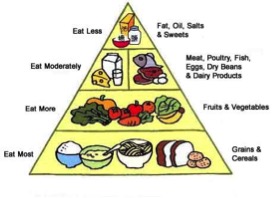Healthy Eating Policy
The original policy was formulated by the staff of St. Patrick’s NS in 2007. This policy was reviewed in October 2013 and again in October 2016 in consultation with staff, parents and the Board of Management. Finally this reviewed policy was ratified on November 14th 2016.
Mission statement.
- Patricks National School, through these guidelines, aims to help all those involved in our school community, children, staff and parents, to develop positive attitudes to eating and healthy living. We wish to promote ‘the personal development and well being of the child and to provide a foundation for healthy living in all its aspects’. (SPHE Guidelines)
- To help achieve this, our guidelines will reflect good eating habits. These should be established at an early age. As children have a right to learn about different foods so that they may make informed choices throughout their life.
- The purpose of making healthy food choices enables children to attain their optimum growth, development and health potential.
- Recent research (Department of Health and Children) has highlighted disturbing trends, including an increase in childhood obesity and diabetes so therefore our policy and guidelines are both timely and critical for the health and development of children.
- Through a whole school approach, and within the context of SPHE the children, parents and staff will learn about nutrition, healthy eating and healthy living.
- Our healthy eating guidelines hope to enable the children to develop and understand of healthy living, and an ability to implement healthy behaviour and willingness to participate in activities that promote and sustain health. This includes physical activity.
- We feel that, in developing the policy, parents, children, teachers, school staff and the BOM should be involved in a collaborative way. We also hope to review these guidelines every two years.
- All classes will receive a least 1 lesson on healthy eating each term.
- School staff will provide supportive attitudes to encourage healthy eating.
- We will also hold a Healthy Eating Awareness week annually.
- Parents will be supported in their role as Primary Educators by providing them with up to date information on healthy eating habits from the Dept. of Health.
Guidelines.
A healthy lunch box includes:
- At least 2 portions from the bread, cereals group.
- One portion from the meat and the meat alternatives group.
- 2/3 portions from fruits and vegetables.
- One portion from the dairy products.
- The following foods do not support a healthy lunch policy and should be excluded from your child’s lunch box; crisps, chewing gum, sweets, bars including cereal bars, cakes, biscuits, lollipops, chocolate, chocolate spread, winders, crispie buns and especially peanuts.
- Due to the incidence of severe allergy to peanuts and mixed nuts amongst some pupils, we ask you to be vigilant in the following:
- Avoid peanuts or any other type of nut in school lunches.
- Avoid giving peanut butter sandwiches, chocolate spreads containing nuts such as Nutella, nut based breads and cereal/health bars containing nuts or labelled “may contain nut traces” in school lunches.
- Ask children not to share their lunches.
- If your child has eaten peanuts/nuts before coming to school, please be sure your child’s hands and face have been thoroughly washed before entering the school.
Healthy snack options (Lower in sugar and fat)
Foods from the top tier of the food pyramid should not be included in your child’s lunchbox.
Sometimes it can be difficult to think of alternatives to these. Here are some tasty alternatives.
- Fruit (for example, an apple or banana, handful of grapes)
- Washed, raw vegetable pieces (for example, sticks of carrot, celery, pepper and cucumber.
- Washed, raw vegetables (for example, cherry tomatoes)
- Half a tin of fruit (in its own juice)
- Plain breadsticks, unsalted plain or wholewheat crackers, crispbreads or water biscuits served with fruit or cheese.
- Plain rice cakes (not chocolate flavoured)
- Natural or low fat yogurt with fresh fruit (fresh, frozen or tinned in its own juice)
- Wholemeal or plain scones.
- Sugar-free jelly pots or fruit jelly.
- Pot of custard or rice pudding.
- Pasta or rice
- Cheese
- Hummus
- Olives
Healthy choices of drink include water, milk and unsweetened natural juice. Children should be encouraged to use re-useable containers for safety and litter reasons. Cans and glass bottles are not permitted. According to the HSE; “there are no recommendations for the amount of water or other fluids children need. However, like adults, to stay healthy it is important for children to replace the water they lose to prevent dehydration. It is also important to remember that children will lose more water in hotter climates and when they have been physically active.” http://www.hse.ie/eng/health/az/D/Dehydration/
